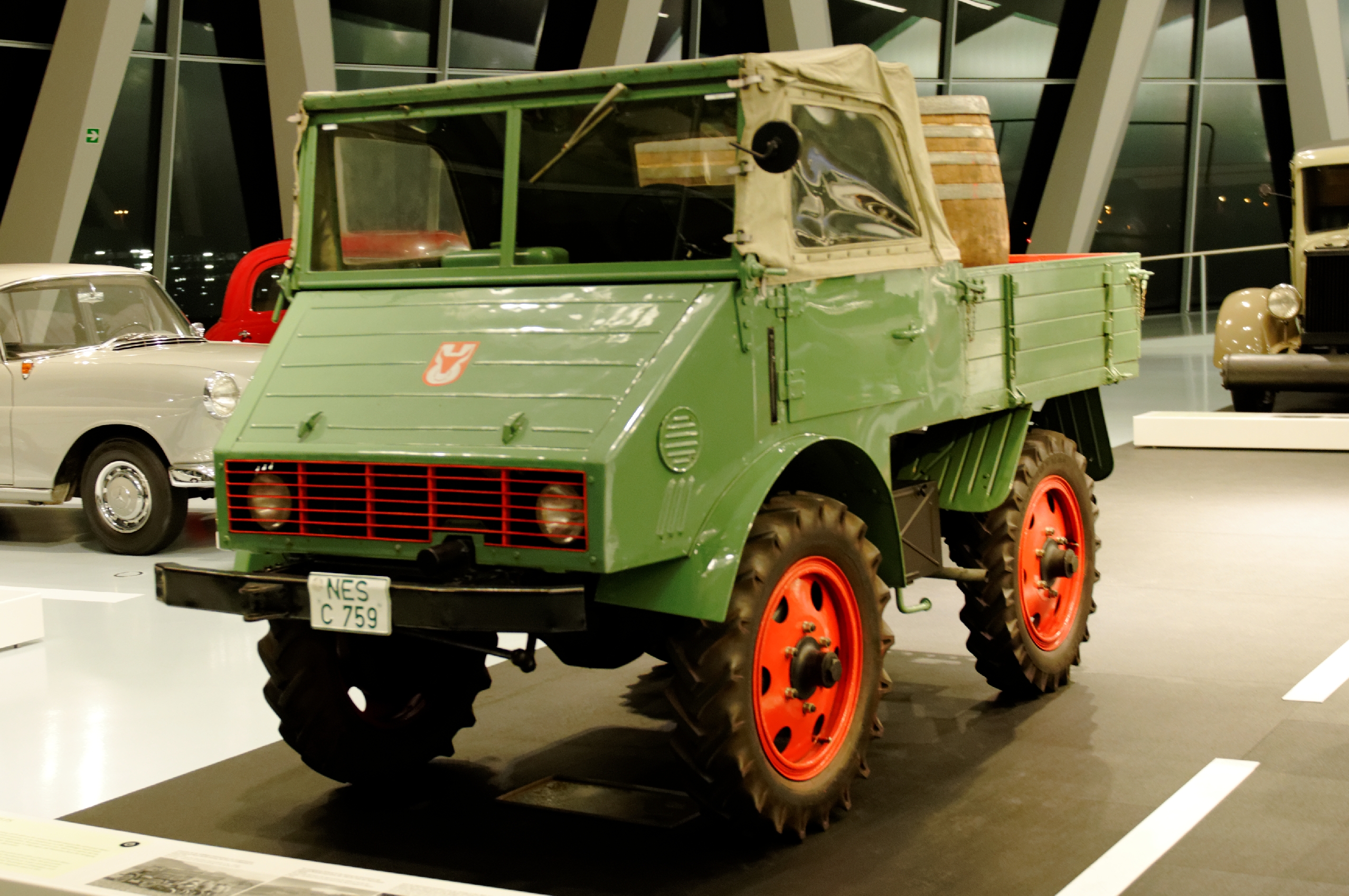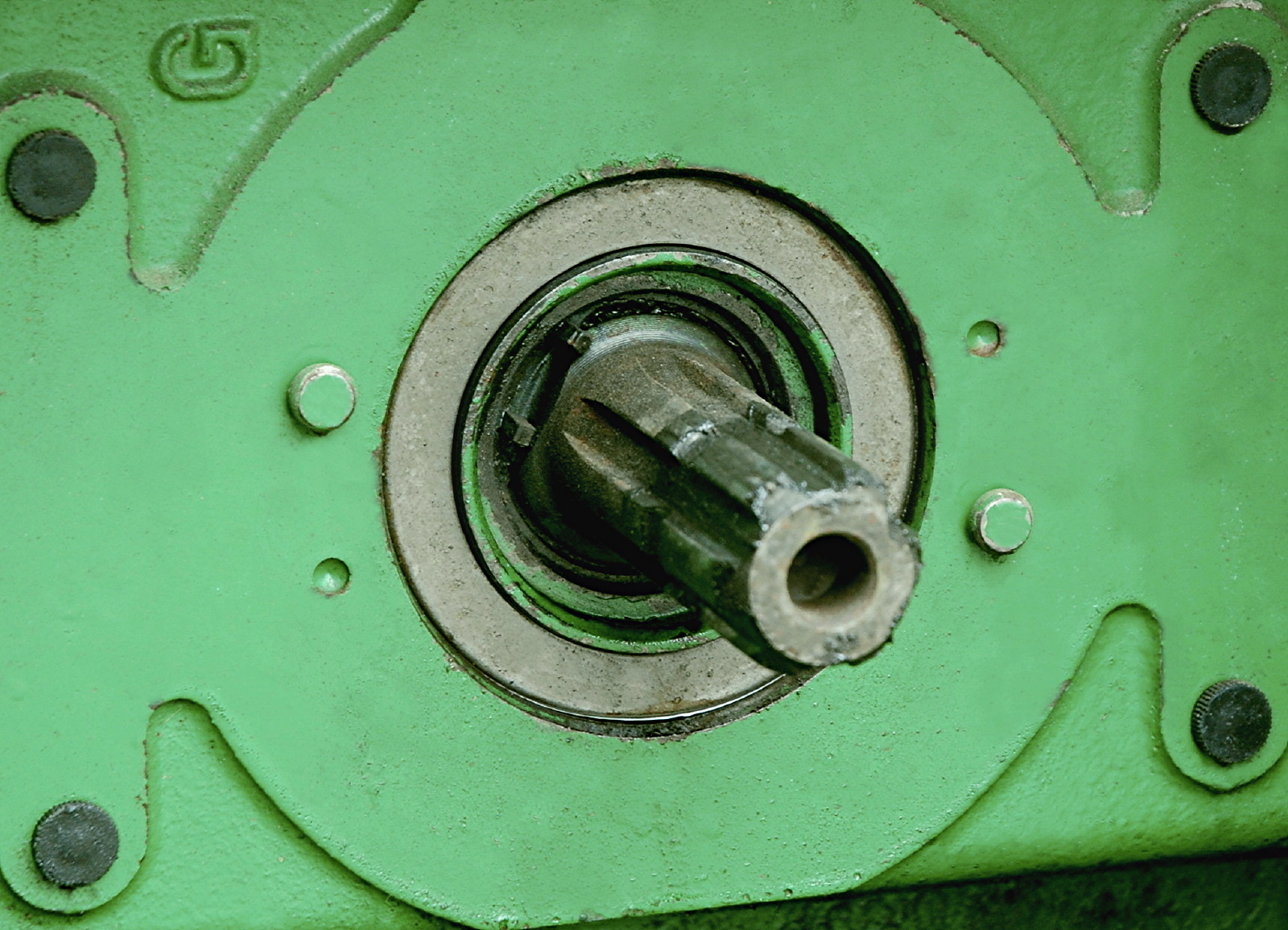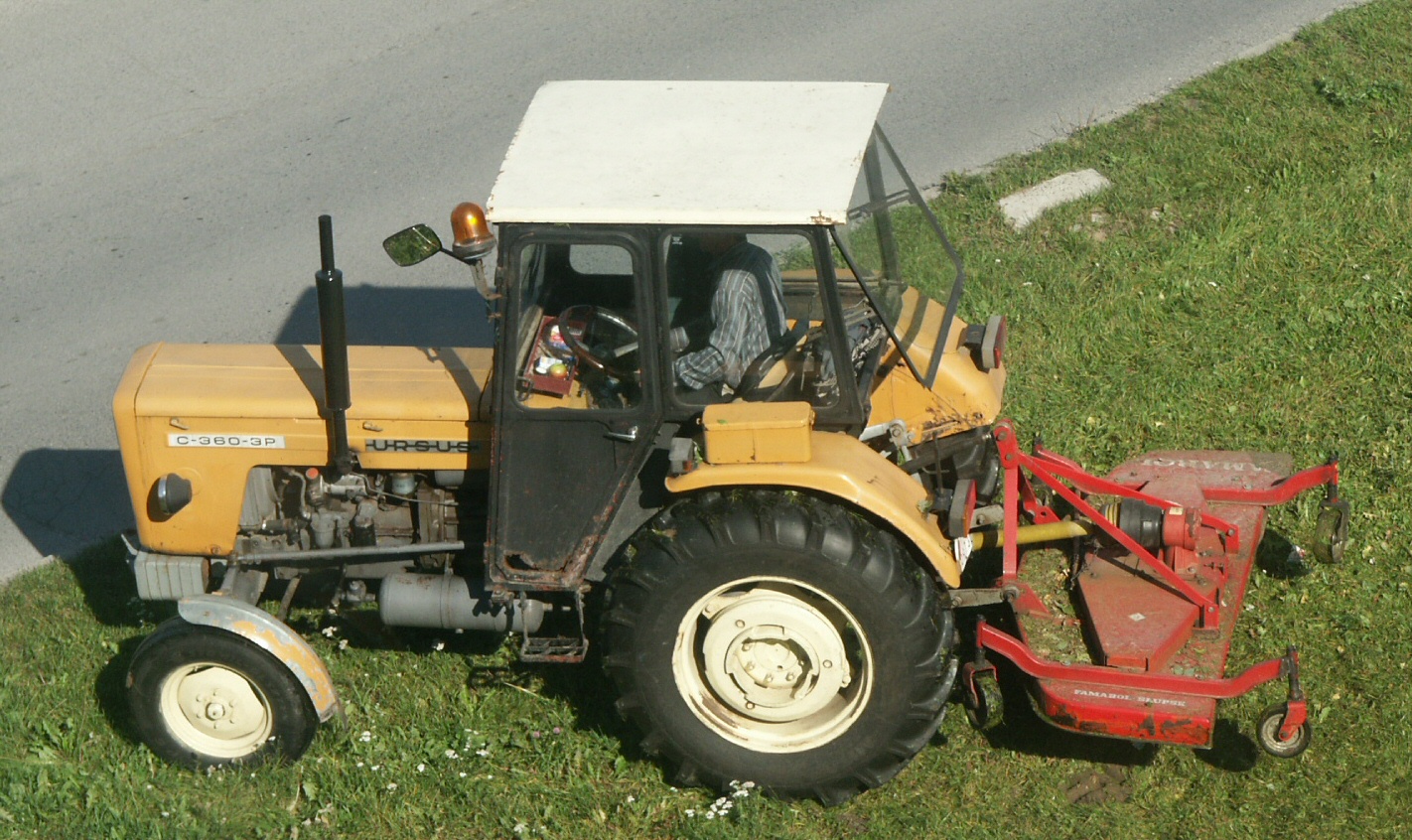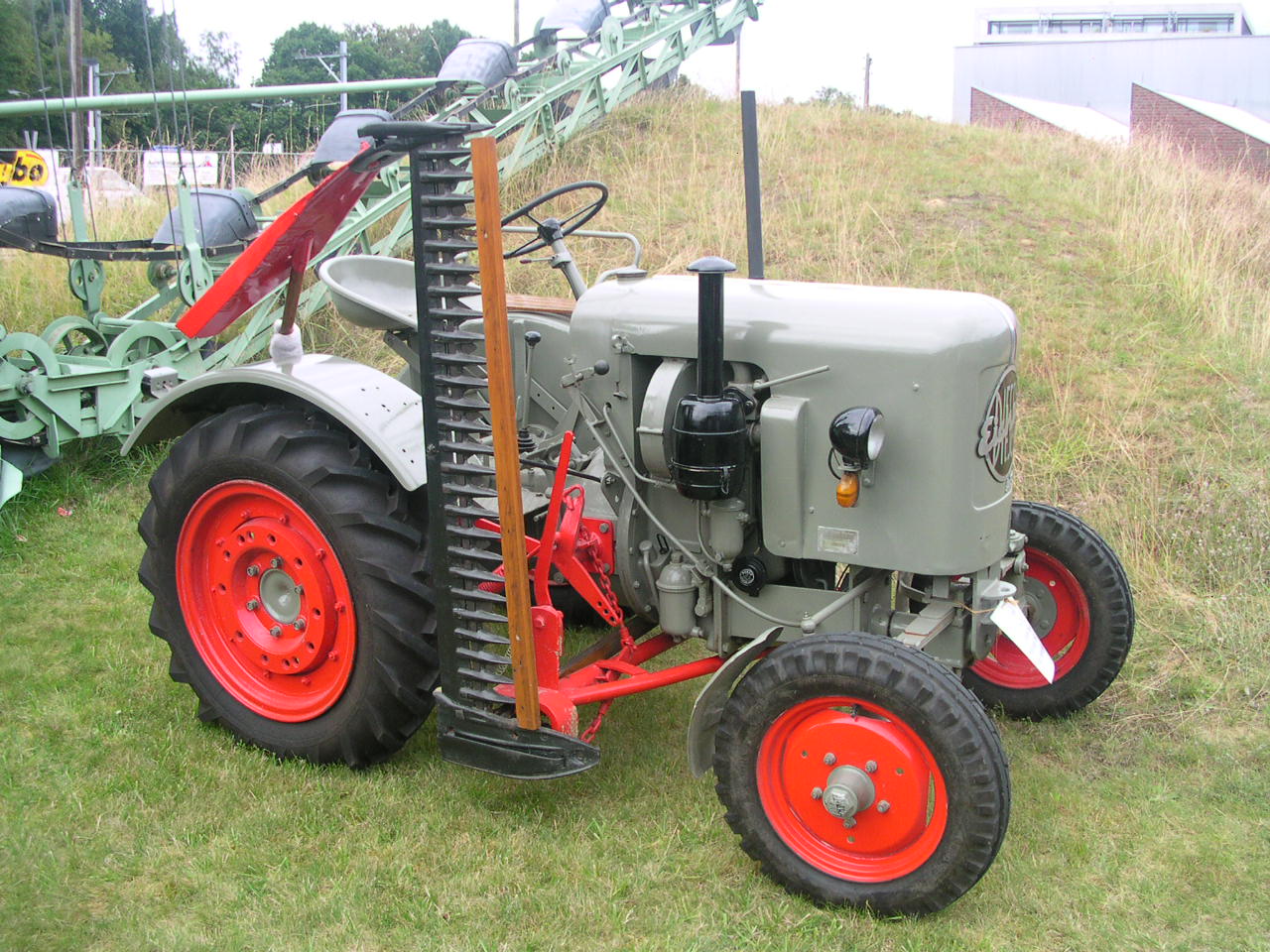|
Flail Mower
A flail mower is a type of powered garden/agricultural equipment which is used to deal with heavier grass/scrub which a normal lawn mower could not cope with. Some smaller models are self-powered, but many are PTO driven implements, which can attach to the three-point hitches found on the rear of most tractors. This type of mower is best used to provide a rough cut to long grass and even brambles in locations such as roadsides, where contact with loose debris may be possible. The flail mower gets its name from the use of flails attached to its rotating horizontal drum (also called tube, rotor, or axle). Many implement companies also refer to the flails as knives, blades or hammers. The rows of flails are usually staggered to give a continuous cut for reduced wear on the machine. The flails are attached to the drum using chain links or brackets, depending on the manufacturer. The rotating drum is parallel to the axle of the tractor. The PTO driveshaft along the tractor's axis mus ... [...More Info...] [...Related Items...] OR: [Wikipedia] [Google] [Baidu] |
Unimog U 400 (2)
The Unimog (, ) is a range of multi-purpose tractors, trucks and lorries that has been produced by Boehringer from 1948 until 1951, and by Daimler Truck (formerly Daimler-Benz, DaimlerChrysler and Daimler AG) since 1951. In the United States and Canada, the Unimog was sold as the Freightliner Unimog. Unimog production started in 1948 at in Göppingen. Daimler-Benz took over manufacture of the Unimog in 1951, and first produced it in their Gaggenau plant. From 1951, the Unimog was sold under the Mercedes-Benz brand. However, the first Unimog to feature the three-pointed Mercedes-Benz star was only introduced in 1953. Since 2002, the Unimog has been built in the Mercedes-Benz truck plant in Wörth am Rhein in Germany. The Mercedes-Benz Türk A.Ş. plant assembles Unimogs in Aksaray, Turkey. Unimogs were also built in Argentina (first ever country to do so outside Germany) by Mercedes-Benz Argentina S.A. under licence from 1968 until 1983 (with some extra units built until 1991 off ... [...More Info...] [...Related Items...] OR: [Wikipedia] [Google] [Baidu] |
Berky Mulcher Typ 5600
The Berky GmbH (former Anton Berkenheger GmbH & Co. KG) is a German company that manufactures machines, specialized vehicles and boats for water maintenance. The company is based in Haren (Ems) in the Emsland region. History The co-founder, farmer and chairman of the Meersbach Water and Soil Association, Anton Berkenheger received the first patent for a hydraulic, three-wheeled special machines for mowing ditch banks in 1963. Together with the civil engineer Gerhard Knoll and Josef Göcking, he founded Anton Berkenheger & Co. KG in Haren-Erika.By 1968, they already employed 15 people. In the same year, the company moved to a production facility at the Haren harbour. In 1977, a new production facility was built in Haren-Emmeln with a total area of 1,500 m2 for production, storage and office. It was expanded in the following years to a total area of about 3,000 m2. By the mid-1980s, the company was already manufacturing and distributing slope mowers, tractor attachments, ... [...More Info...] [...Related Items...] OR: [Wikipedia] [Google] [Baidu] |
Power Take-off
A power take-off or power takeoff (PTO) is one of several methods for taking power from a power source, such as a running engine, and transmitting it to an application such as an attached implement or separate machine. Most commonly, it is a splined drive shaft installed on a tractor or truck allowing implements with mating fittings to be powered directly by the engine. Semi-permanently mounted power take-offs can also be found on industrial and marine engines. These applications typically use a drive shaft and bolted joint to transmit power to a secondary implement or accessory. In the case of a marine application, such shafts may be used to power fire pumps. In aircraft applications, such an accessory drive may be used in conjunction with a constant speed drive. Jet aircraft have four types of PTO units: internal gearbox, external gearbox, radial drive shaft, and bleed air, which are used to power engine accessories. In some cases, aircraft power take-off systems also provid ... [...More Info...] [...Related Items...] OR: [Wikipedia] [Google] [Baidu] |
Three-point Hitch
The three-point hitch (British English: three-point linkage) is a widely used type of hitch for attaching ploughs and other implements to an agricultural or industrial tractor. The three points resemble either a triangle, or the letter A. Three-point attachment is the simplest and the only statically determinate way of joining two bodies in engineering. A three-point hitch attaches the implement to the tractor so that the orientation of the implement is fixed with respect to the tractor and the arm position of the hitch. The tractor carries some or all of the weight of the implement. The other main mechanism for attaching a load is through a drawbar, a single point, pivoting attachment where the implement or trailer is not in a fixed position with respect to the tractor. The primary benefit of the three-point hitch system is to transfer the weight and resistance of an implement to the drive wheels of the tractor. This gives the tractor more usable traction than it would otherw ... [...More Info...] [...Related Items...] OR: [Wikipedia] [Google] [Baidu] |
Tractor
A tractor is an engineering vehicle specifically designed to deliver a high tractive effort (or torque) at slow speeds, for the purposes of hauling a trailer or machinery such as that used in agriculture, mining or construction. Most commonly, the term is used to describe a farm vehicle that provides the power and traction to mechanize agricultural tasks, especially (and originally) tillage, and now many more. Agricultural implements may be towed behind or mounted on the tractor, and the tractor may also provide a source of power if the implement is mechanised. Etymology The word ''tractor'' was taken from Latin, being the agent noun of ''trahere'' "to pull". The first recorded use of the word meaning "an engine or vehicle for pulling wagons or plows" occurred in 1896, from the earlier term " traction motor" (1859). National variations In the UK, Ireland, Australia, India, Spain, Argentina, Slovenia, Serbia, Croatia, the Netherlands, and Germany, the word "tractor" u ... [...More Info...] [...Related Items...] OR: [Wikipedia] [Google] [Baidu] |
Mower
A mower is a person or machine that cuts (mows) grass or other plants that grow on the ground. Usually mowing is distinguished from reaping, which uses similar implements, but is the traditional term for harvesting grain crops, e.g. with reapers and combines. A smaller mower used for lawns and sports grounds (playing fields) is called a ''lawn mower'' or ''grounds mower'', which is often self-powered, or may also be small enough to be pushed by the operator. Grounds mowers have reel or rotary cutters. Larger mowers or '' mower-conditioners'' are mainly used to cut grass (or other crops) for hay or silage and often place the cut material into rows, which are referred to as ''windrows''. '' Swathers'' (or ''windrowers'') are also used to cut grass (and grain crops). Prior to the invention and adoption of mechanized mowers, (and today in places where use a mower is impractical or uneconomical), grass and grain crops were cut by hand using scythes or sickles. Mower configurations ... [...More Info...] [...Related Items...] OR: [Wikipedia] [Google] [Baidu] |
Grass
Poaceae () or Gramineae () is a large and nearly ubiquitous family of monocotyledonous flowering plants commonly known as grasses. It includes the cereal grasses, bamboos and the grasses of natural grassland and species cultivated in lawns and pasture. The latter are commonly referred to collectively as grass. With around 780 genera and around 12,000 species, the Poaceae is the fifth-largest plant family, following the Asteraceae, Orchidaceae, Fabaceae and Rubiaceae. The Poaceae are the most economically important plant family, providing staple foods from domesticated cereal crops such as maize, wheat, rice, barley, and millet as well as feed for meat-producing animals. They provide, through direct human consumption, just over one-half (51%) of all dietary energy; rice provides 20%, wheat supplies 20%, maize (corn) 5.5%, and other grains 6%. Some members of the Poaceae are used as building materials (bamboo, thatch, and straw); others can provide a source of biofuel, ... [...More Info...] [...Related Items...] OR: [Wikipedia] [Google] [Baidu] |
Brambles
A bramble is any rough, tangled, prickly shrub, usually in the genus ''Rubus'', which grows blackberries, raspberries, or dewberries. "Bramble" is also used to describe other prickly shrubs, such as roses (''Rosa'' species). The fruits include blackberries, arctic brambleberries, or raspberries, depending on the species, and are used to make jellies, jams, and preserves. In British English, bramble usually refers to the common blackberry, ''Rubus fruticosus''. ''R. fruticosus'' grows abundantly in all parts of the British Isles, and harvesting the fruits in late summer and autumn is often considered a favourite pastime. An especially hardy plant, bramble bushes can also become a nuisance in gardens, sending down strong suckering roots amongst hedges and shrubs and being particularly resilient against pruning. Many consider ''R. fruticosus'' a weed due its tendency to grow in neglected areas and its sharp, tough thorns, which can be hazardous to children and pets. ... [...More Info...] [...Related Items...] OR: [Wikipedia] [Google] [Baidu] |
Flail
A flail is an agricultural tool used for threshing, the process of separating grains from their husks. It is usually made from two or more large sticks attached by a short chain; one stick is held and swung, causing the other (the swipple) to strike a pile of grain, loosening the husks. The precise dimensions and shape of flails were determined by generations of farmers to suit the particular grain they were harvesting. For example, flails used by farmers in Quebec to process wheat were generally made from two pieces of wood, the handle being about long by in diameter, and the second stick being about long by about in diameter, with a slight taper towards the end. Flails for other grains, such as rice or spelt, would have had different dimensions. Flails have generally fallen into disuse in many nations because of the availability of technologies such as combine harvesters that require much less manual labour. But in many places, such as Minnesota, wild rice can only be harv ... [...More Info...] [...Related Items...] OR: [Wikipedia] [Google] [Baidu] |
Drive Shaft
A drive shaft, driveshaft, driving shaft, tailshaft (Australian English), propeller shaft (prop shaft), or Cardan shaft (after Girolamo Cardano) is a component for transmitting mechanical power (physics), power and torque and rotation, usually used to connect other components of a drivetrain that cannot be connected directly because of distance or the need to allow for relative movement between them. As torque carriers, drive shafts are subject to torsion (mechanics), torsion and shear stress, equivalent to the difference between the input torque and the load. They must therefore be strong enough to bear the stress, while avoiding too much additional weight as that would in turn increase their inertia. To allow for variations in the alignment and distance between the driving and driven components, drive shafts frequently incorporate one or more universal joints, jaw couplings, or rag joints, and sometimes a Rotating spline, splined joint or prismatic joint. History The term ' ... [...More Info...] [...Related Items...] OR: [Wikipedia] [Google] [Baidu] |
Hedge Trimmer
A hedge trimmer, shrub trimmer, or bush trimmerAs with the term ''scissors'', the plural terms "hedge trimmers" + c. are often used for individual trimming tools. is a gardening tool or machine used for trimming (cutting, pruning) hedges or solitary shrubs (bushes). Different designs as well as manual and powered versions of hedge trimmers exist. Hedge trimmers vary between small hand-held devices to larger trimmers mounted on tractors. Types Stand-alone hedge trimmers The power source of stand-alone hedge trimmers can be human power, gasoline, or electricity. * Manual hedge trimmers (sometimes also called hedge shears or hedge clippers) are designed as large scissors or large pruning shears. They do not need anything to operate and are cheapest/most environmentally friendly. * Motorized hedge trimmers allow work to be done faster and with less effort than manual ones. Their cutting mechanism is similar to that of finger-bar mowers. Powered trimmers are generally designed wi ... [...More Info...] [...Related Items...] OR: [Wikipedia] [Google] [Baidu] |






